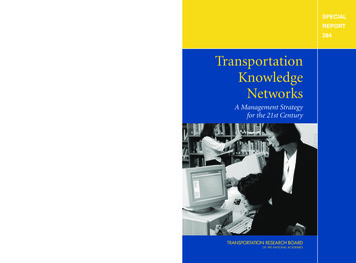
Transcription
SPECIALREPORTTransportation Knowledge Networks284A Management Strategy for the 21st CenturySPECIAL REPORT 284To perform their work, to carry out the mission-critical goals of their organizations, andto remain on the cutting edge of new research and technologies, public- and privatesector transportation professionals require rapid delivery of reliable information and data.The authoring committee of this report provides strategic advice to the federal and stategovernments about a sustainable administrative structure and funding mechanism to meetthe information service needs of the transportation sector. The report identifies the coreservices, how to provide those services, and the funding options to support those services.Also of InterestA Management Strategyfor the 21st CenturyThe Successful Adoption of Web-Based Collaborative SoftwareTransit Cooperative Research Program Report 84, Volume 7, ISBN 0-309-06766-9, 66 pages,8.5 x 11, paperback, 2005, 21.00Enhancing the Value of Data Programs: A Peer ExchangeTRB Transportation Research E-Circular 77, 52 pages, ISSN 0097-8515, ata for Understanding Our Nation’s Travel: National Household Travel Survey ConferenceTRB Transportation Research E-Circular 71, 78 pages, ISSN 0097-8515, C21: A Digital Strategy for the Library of CongressNational Research Council, National Academies Press, 288 pages, ISBN 0-309-07144-5, 6 x 9,2000, 35.00Applying Advanced Information Systems to Ports and Waterways ManagementTRB Marine Board, National Academies Press, 66 pages, ISBN 0-309-06380-9, 8.5 x 11, 1999, 23.00ISBN 0-309-09420-8Transportation Knowledge NetworksSummary of a Workshop on Using Information Technology to Enhance Disaster ManagementNational Research Council, National Academies Press, 40 pages, ISBN 0-309-10037-2, 8.5 x 11,paperback, 2005, 12.00TransportationKnowledgeNetworks
TRANSPORTATION RESEARCH BOARD2006 EXECUTIVE COMMITTEE*Chair: Michael D. Meyer, Professor, School of Civil and Environmental Engineering, Georgia Institute ofTechnology, AtlantaVice Chair: Linda S. Watson, Executive Director, LYNX–Central Florida Regional Transportation Authority,OrlandoExecutive Director: Robert E. Skinner, Jr., Transportation Research BoardMichael W. Behrens, Executive Director, Texas Department of Transportation, AustinAllen D. Biehler, Secretary, Pennsylvania Department of Transportation, HarrisburgJohn D. Bowe, Regional President, APL Americas, Oakland, CaliforniaLarry L. Brown, Sr., Executive Director, Mississippi Department of Transportation, JacksonDeborah H. Butler, Vice President, Customer Service, Norfolk Southern Corporation and Subsidiaries,Atlanta, GeorgiaAnne P. Canby, President, Surface Transportation Policy Project, Washington, D.C.Douglas G. Duncan, President and CEO, FedEx Freight, Memphis, TennesseeNicholas J. Garber, Henry L. Kinnier Professor, Department of Civil Engineering, University of Virginia,CharlottesvilleAngela Gittens, Vice President, Airport Business Services, HNTB Corporation, Miami, FloridaGenevieve Giuliano, Professor and Senior Associate Dean of Research and Technology, School of Policy, Planning,and Development, and Director, METRANS National Center for Metropolitan Transportation Research,University of Southern California, Los Angeles (Past Chair, 2003)Susan Hanson, Landry University Professor of Geography, Graduate School of Geography, Clark University,Worcester, MassachusettsJames R. Hertwig, President, CSX Intermodal, Jacksonville, FloridaAdib K. Kanafani, Cahill Professor of Civil Engineering, University of California, BerkeleyHarold E. Linnenkohl, Commissioner, Georgia Department of Transportation, AtlantaSue McNeil, Professor, Department of Civil and Environmental Engineering, University of Delaware, NewarkDebra L. Miller, Secretary, Kansas Department of Transportation, TopekaMichael R. Morris, Director of Transportation, North Central Texas Council of Governments, ArlingtonCarol A. Murray, Commissioner, New Hampshire Department of Transportation, ConcordJohn R. Njord, Executive Director, Utah Department of Transportation, Salt Lake City (Past Chair, 2005)Sandra Rosenbloom, Professor of Planning, University of Arizona, TucsonHenry Gerard Schwartz, Jr., Senior Professor, Washington University, St. Louis, MissouriMichael S. Townes, President and CEO, Hampton Roads Transit, Virginia (Past Chair, 2004)C. Michael Walton, Ernest H. Cockrell Centennial Chair in Engineering, University of Texas, AustinMarion C. Blakey, Administrator, Federal Aviation Administration, U.S. Department of Transportation (ex officio)Joseph H. Boardman, Administrator, Federal Railroad Administration, U.S. Department of Transportation(ex officio)Rebecca M. Brewster, President and COO, American Transportation Research Institute, Smyrna, Georgia(ex officio)George Bugliarello, Chancellor, Polytechnic University of New York, Brooklyn; Foreign Secretary, NationalAcademy of Engineering, Washington, D.C. (ex officio)Sandra K. Bushue, Deputy Administrator, Federal Transit Administration, U.S. Department of Transportation(ex officio)J. Richard Capka, Acting Administrator, Federal Highway Administration, U.S. Department of Transportation(ex officio)Thomas H. Collins (Adm., U.S. Coast Guard), Commandant, U.S. Coast Guard, Washington, D.C. (ex officio)James J. Eberhardt, Chief Scientist, Office of FreedomCAR and Vehicle Technologies, U.S. Department of Energy(ex officio)Jacqueline Glassman, Deputy Administrator, National Highway Traffic Safety Administration, U.S. Department ofTransportation (ex officio)Edward R. Hamberger, President and CEO, Association of American Railroads, Washington, D.C. (ex officio)John C. Horsley, Executive Director, American Association of State Highway and Transportation Officials,Washington, D.C. (ex officio)John E. Jamian, Acting Administrator, Maritime Administration, U.S. Department of Transportation (ex officio)J. Edward Johnson, Director, Applied Science Directorate, National Aeronautics and Space Administration, John C.Stennis Space Center, Mississippi (ex officio)Ashok G. Kaveeshwar, Administrator, Research and Innovative Technology Administration, U.S. Department ofTransportation (ex officio)Brigham McCown, Deputy Administrator, Pipeline and Hazardous Materials Safety Administration, U.S.Department of Transportation (ex officio)William W. Millar, President, American Public Transportation Association, Washington, D.C. (ex officio) (PastChair, 1992)Suzanne Rudzinski, Director, Transportation and Regional Programs, U.S. Environmental Protection Agency(ex officio)Annette M. Sandberg, Administrator, Federal Motor Carrier Safety Administration, U.S. Department ofTransportation (ex officio)Jeffrey N. Shane, Under Secretary for Policy, U.S. Department of Transportation (ex officio)Carl A. Strock (Maj. Gen., U.S. Army), Chief of Engineers and Commanding General, U.S. Army Corps ofEngineers, Washington, D.C. (ex officio)*Membership as of March 2006.
SPECIAL REPORT 284TransportationKnowledgeNetworksA Management Strategy for the21st CenturyCommittee for a Future Strategy forTransportation Information ManagementTRANSPORTATION RESEARCH BOARDOF THE NATIONAL ACADEMIESTransportation Research BoardWashington, D.C.2006www.TRB.org
Transportation Research Board Special Report 284Subscriber CategoryIA planning and administrationTransportation Research Board publications are available by ordering individual publications directly from the TRB Business Office, through the Internet at www.TRB.org ornational-academies.org/trb, or by annual subscription through organizational or individual affiliation with TRB. Affiliates and library subscribers are eligible for substantialdiscounts. For further information, contact the Transportation Research Board BusinessOffice, 500 Fifth Street, NW, Washington, DC 20001 (telephone 202-334-3213; fax 202334-2519; or e-mail TRBsales@nas.edu).Copyright 2006 by the National Academy of Sciences. All rights reserved.Printed in the United States of America.NOTICE: The project that is the subject of this report was approved by the GoverningBoard of the National Research Council, whose members are drawn from the councils ofthe National Academy of Sciences, the National Academy of Engineering, and the Institute of Medicine. The members of the committee responsible for the report were chosenfor their special competencies and with regard for appropriate balance.This report has been reviewed by a group other than the authors according to the procedures approved by a Report Review Committee consisting of members of the NationalAcademy of Sciences, the National Academy of Engineering, and the Institute of Medicine.This study was sponsored by the National Cooperative Highway Research Program.Library of Congress Cataloging-in-Publication DataNational Research Council (U.S.). Committee for a Future Strategy forTransportation Information Management.Transportation knowledge networks : a management strategy forthe 21st century / Committee for a Future Strategy forTransportation Information Management, Transportation ResearchBoard of the National Academies.p. cm.—(Special report ; 284)ISBN 0-309-09420-81. Transportation and state—United States. 2. Transportationplanning—United States. 3. Knowledge management—United States. 4.Business networks—United States. I. National Research Council (U.S.).Transportation Research Board. II. Title. III. Special report (NationalResearch Council (U.S.). Transportation Research Board) ; 284.HE206.2.N39 2006354.76'238—dc222006040459
The National Academy of Sciences is a private, nonprofit, self-perpetuating society ofdistinguished scholars engaged in scientific and engineering research, dedicated to thefurtherance of science and technology and to their use for the general welfare. On the authority of the charter granted to it by the Congress in 1863, the Academy has a mandatethat requires it to advise the federal government on scientific and technical matters.Dr. Ralph J. Cicerone is president of the National Academy of Sciences.The National Academy of Engineering was established in 1964, under the charter of theNational Academy of Sciences, as a parallel organization of outstanding engineers. It isautonomous in its administration and in the selection of its members, sharing with theNational Academy of Sciences the responsibility for advising the federal government. TheNational Academy of Engineering also sponsors engineering programs aimed at meeting national needs, encourages education and research, and recognizes the superiorachievements of engineers. Dr. William A. Wulf is president of the National Academy ofEngineering.The Institute of Medicine was established in 1970 by the National Academy of Sciences tosecure the services of eminent members of appropriate professions in the examination ofpolicy matters pertaining to the health of the public. The Institute acts under the responsibility given to the National Academy of Sciences by its congressional charter to be an adviser to the federal government and, on its own initiative, to identify issues of medical care,research, and education. Dr. Harvey V. Fineberg is president of the Institute of Medicine.The National Research Council was organized by the National Academy of Sciences in1916 to associate the broad community of science and technology with the Academy’s purposes of furthering knowledge and advising the federal government. Functioning in accordance with general policies determined by the Academy, the Council has become theprincipal operating agency of both the National Academy of Sciences and the NationalAcademy of Engineering in providing services to the government, the public, and the scientific and engineering communities. The Council is administered jointly by both theAcademies and the Institute of Medicine. Dr. Ralph J. Cicerone and Dr. William A. Wulfare chair and vice chair, respectively, of the National Research Council.The Transportation Research Board is a division of the National Research Council,which serves the National Academy of Sciences and the National Academy of Engineering. The Board’s mission is to promote innovation and progress in transportation throughresearch. In an objective and interdisciplinary setting, the Board facilitates the sharing ofinformation on transportation practice and policy by researchers and practitioners; stimulates research and offers research management services that promote technical excellence; provides expert advice on transportation policy and programs; and disseminatesresearch results broadly and encourages their implementation. The Board’s varied activities annually engage more than 5,000 engineers, scientists, and other transportation researchers and practitioners from the public and private sectors and academia, all of whomcontribute their expertise in the public interest. The program is supported by state transportation departments, federal agencies including the component administrations of theU.S. Department of Transportation, and other organizations and individuals interestedin the development of transportation. www.TRB.orgwww.national-academies.org
Committee for a Future Strategyfor Transportation Information ManagementFrancis B. Francois, American Association of State Highway andTransportation Officials (retired), ChairGary R. Allen, Virginia Department of Transportation, CharlottesvilleLance R. Grenzeback, Cambridge Systematics, Inc., Cambridge,MassachusettsRobert C. Johns, University of Minnesota, MinneapolisR. David Lankes, Syracuse University, New YorkCharles R. McClure, Florida State University, TallahasseeNina McLawhorn, Wisconsin Department of Transportation, MadisonMichael D. Meyer, Georgia Institute of Technology, AtlantaEllen (Leni) Oman, Washington State Department of Transportation,OlympiaBonnie A. Osif, Pennsylvania State University, University ParkRoberto A. Sarmiento, Northwestern University, Evanston, IllinoisLisa Zeimer, Parsons Brinckerhoff Quade and Douglas, Baltimore,MarylandTransportation Research Board StaffNancy P. Humphrey, Study Director
PrefaceInformation technology has transformed the way users access informationand the volume of information available, resulting in both new opportunities (e.g., desktop information access) and new problems (e.g., information overload). In this context, the Standing Committee on Research of theAmerican Association of State Highway and Transportation Officials(AASHTO) funded a study by the Transportation Research Board (TRB)of the National Research Council (NRC) designed to lay out a futurecourse for managing transportation information in the information age.In response to this request, TRB formed a committee chaired byFrancis B. Francois, former Executive Director of AASHTO. The 12 committee members brought to the study expertise in information and computer science, library science and management, transportation policy andresearch, and transportation agency and research administration.The committee supplemented its own expertise by drawing on an exploratory study conducted for AASHTO by Barbara T. Harder (B. T.Harder, Inc.) and Sandra L. Tucker (Texas Transportation Institute) entitled Scoping Study for a National Strategic Plan for Transportation Information Management. Completed in June 2002, this study comparedexisting transportation information services with current needs throughstructured interviews with a wide range of transportation users. In addition, the committee was briefed at its first two meetings by numerousexperts on national libraries and various network and consortium arrangements with the potential to serve as models for managing informationin the transportation sector. In particular, the committee thanks PeterYoung, director of the National Agricultural Library; Jane BortnickGriffith, acting deputy director of the National Library of Medicine; NeldaE. Bravo, head of the National Transportation Library; Christine Dunn,vii
viiiTransportation Knowledge Networks: A Management Strategy for the 21st Centuryexecutive director of the National Library of Education (interviewed bytelephone); Kate Nevins, executive director of the Southeast Library Network, Inc.; Joan K. Lippincott, associate executive director of the Coalitionfor Networked Information; and Mary Chute, deputy director for LibraryServices of the Institute of Museum and Library Services. In addition, CarlLagoze, senior research associate at Cornell University, briefed the committee on the Digital Library Initiative of the National Science Foundationand on the 2000 NRC Study for a Digital Strategy for the Library of Congress. The committee also thanks Eric C. Peterson, deputy administratorfor the Research and Innovative Technology Administration (RITA) in theU.S. Department of Transportation, and Harold C. Relyea, specialist inAmerican national government with the Congressional Research Serviceof the Library of Congress, who met with the committee chair and TRBstaff to discuss future options for the National Transportation Library andthe pros and cons of other federal organizational alternatives for a transportation information management system, respectively.Finally, the committee acknowledges Jerome C. Baldwin, director of theMinnesota Department of Transportation Library, who provided thecommittee with numerous baseline surveys on state department of transportation library staffing and budgets; Andrew C. Lemer, senior staff, TRB,who assisted with formation of the committee; Barbara L. Post, managerof information services, Christopher J. Hedges, senior program officer,and Thomas M. Palmerlee, transportation data specialist, all at TRB, fortheir thoughtful observations and assistance throughout the study; andJohn McCracken, director of the Office of Research and Technology Services at the Turner-Fairbank Highway Research Center, Timothy A. Klein,senior advisor in RITA, and Thomas G. Bolle, deputy director for governmental, international, and public affairs in RITA, for their interest and participation in the open sessions of the committee meetings.This report has been reviewed in draft form by individuals chosen fortheir diverse perspectives and technical expertise, in accordance with procedures approved by NRC’s Report Review Committee. The purpose ofthis independent review is to provide candid and critical comments thatassist the authors and NRC in making the published report as sound aspossible and to ensure that the report meets institutional standards for objectivity, evidence, and responsiveness to the study charge. The contents of
Prefaceixthe review comments and draft manuscript remain confidential to protectthe integrity of the deliberative process. The committee thanks the following individuals for their participation in the review of this report: E. DeanCarlson, Carlson Associates, Topeka, Kansas; Daniel C. Krummes, University of California, Berkeley; Ronald Larsen, University of Pittsburgh;Richard C. Long, Florida Department of Transportation, Tallahassee;Carol A. Murray, New Hampshire Department of Transportation, Concord; and Jeanne F. Thomas, Strategy Group, Inc., Scottsdale, Arizona.Although the reviewers listed above provided many constructive comments and suggestions, they were not asked to endorse the committee’sconclusions or recommendations, nor did they see the final draft of thereport before its release. The review of this report was overseen by LesterA. Hoel, University of Virginia, and C. Michael Walton, University ofTexas at Austin. Appointed by NRC, they were responsible for makingcertain that an independent examination of the report was carried out inaccordance with institutional procedures and that all review commentswere carefully considered. Responsibility for the final content of this report rests entirely with the authoring committee and the institution.Nancy P. Humphrey managed the study and drafted the final reportunder the guidance of the committee and the supervision of Stephen R.Godwin, director of studies and information services. Suzanne Schneider,associate executive director of TRB, managed the report review process.Special appreciation is expressed to Rona Briere, who edited the report.Jennifer J. Weeks prepared the prepublication copy of this report, andJuanita Green managed the book design and production under the supervision of Javy Awan, director of publications. Alisa Decatur providedword processing support, and Amelia Mathis assisted with meetingarrangements and communications with committee members.
ContentsExecutive Summary1 Introduction113Study Charge and ScopeBackground and Impetus for the StudyInformation Management in the Information AgeThe Value of InformationOrganization of the Report14152529352 Toward a Nationwide Transportation InformationManagement System37Models for Managing Information ServicesOverview of a Proposed Transportation InformationManagement SystemBenefitsDevelopment of TKNsDevelopment of a National Coordinating StructureFrom Proposal to Implementation3 AdministrationCharacteristics for Successful OperationComparison of OptionsRecommended LocationGovernance3748505355596161626869
4 Funding OptionsFunding CharacteristicsPotential Funding SourcesProposed Funding StrategyNext StepsStudy Committee Biographical Information737374788183
Executive SummaryIn today’s information age, public- and private-sector transportation professionals seek rapid delivery of reliable information and data1 to enablethem to perform their work, carry out the mission-critical goals of theirorganizations, and remain on the cutting edge of new research and technologies. The Internet and search engines—such as Google and Yahoo!—have transformed the scale and scope of information available to users andthe way that information is accessed and delivered. Users can now obtaina broad array of information at their desktops.The increasing amount of information available through the Internethas caused many transportation agencies, associations, and consultingfirms to question the need for traditional transportation libraries. As aresult, a number of transportation libraries have been downsized, seentheir budgets reduced, or been required to justify their value repeatedlyand aggressively. For example, the U.S. Department of Transportation(USDOT) headquarters library has been downsized, several state DOTlibraries have lost staff and funding, and some have been closed.Despite the wealth of information on the Internet, transportation professionals still report that they face an overwhelming volume of information and have difficulty locating and retrieving many technical reports,even those in digital form. Professionals in other fields, such as health andagriculture, have addressed this problem by transforming, not closing, theirlibraries. As information has become increasingly electronic and widely1The study committee distinguished among data, information, and knowledge. Data consist of facts,measurements, or statistics, which can be thought of as the raw material of information. Information is data organized in a form useful for analysis and decision making. Knowledge is informationthat has been combined with experience, context, and interpretation that make it possible to understand and draw implications from both data and information. At the same time, for purposes ofconciseness, this report often uses the term “information” more loosely to encompass data as well.1
2Transportation Knowledge Networks: A Management Strategy for the 21st Centurydistributed, their libraries have evolved from centralized and managedphysical collections into decentralized networks providing informationservices to users wherever they reside. Physical collections remain criticallyimportant to maintain historical information and printed reference materials, but forward-looking libraries have developed new approaches formanaging and adding value to widely dispersed information sources. Withthe help of information technology professionals and communicationsexperts in coordinating information delivery, they offer many servicesthrough their decentralized networks of information providers.The transportation sector needs to do more to transform its libraries tomeet the demands of the information age. In 1998 USDOT established acongressionally authorized National Transportation Library (NTL). Originally intended as a digital collection only, NTL was charged with coordinating information sharing among other transportation libraries andinformation providers to facilitate access to their materials by the transportation community. Without consistent USDOT support and funding,however, NTL has been able to operate only within a narrow definition ofits mission.Concerned by the above trends and growing user demand for information services better geared to new technologies, the Standing Committeeon Research (SCOR) of the American Association of State Highway andTransportation Officials (AASHTO) requested that the TransportationResearch Board (TRB) conduct a study to take a fresh look at how transportation information should be managed and provided. AASHTOdirected that an expert committee be formed to carry out the study andprovide strategic advice to the federal government and the states withregard to a sustainable administrative structure and funding mechanismfor meeting the information service needs of the transportation sector.THE STATE OF TRANSPORTATION INFORMATIONMANAGEMENT AND THE CASE FOR CHANGETransportation information professionals first laid out a vision for a transportation information management system in the early 1970s that includedan evolving network of information services and users, a nationallevel coordinating unit, and stable and broad-based financial support.
Executive Summary3Although the whole system was never established, major elements arein place: In 1970 TRB developed the Transportation Research Information Service (TRIS)—a bibliographic database of transportation research—which it has managed since that time. In 1996 TRB developed a Transportation Thesaurus to improve andstandardize the indexing and retrieval of transportation information. Collections of many U.S. transportation libraries have been cataloguedin the Online Computer Library Center. The Transportation Libraries Catalog (TLCat), which enables users tosearch multiple transportation library holdings in a single catalogue,was launched in 2004. NTL has built a small digital collection of noncopyrighted researchreports, provides free access to TLCat, offers reference services, andmade available seed funds to create a pilot regional consortium oflibraries—the Midwest Transportation Knowledge Network (MTKN). Ten state DOTs and one University Transportation Center have pooledfunds to support a Transportation Library Connectivity project.Despite these initiatives, the primary elements of the original vision ofa transportation information management system have not been realized.Most notably absent are a sustainable coordinating mechanism and stablefinancial support. Indeed, compared with other major sectors of the economy that support national libraries and broad networks of informationproviders, such as health and agriculture, the transportation sector devotesrelatively few resources to information services. In short, the transportation sector’s approach to information management is piecemeal, unevenlyfunded, and largely dependent on informal institutional arrangements.In today’s digital age, why are transportation libraries and information services not more valued? First, cost-conscious managers ask whythe personnel costs and space requirements of running a library and providing information services are necessary when users can simply summon up the information they require at their desktops. Second, likeresearch, good information is often taken for granted, and its benefits arenot always evident. Finally, the services offered by librarians are frequently not known, particularly at the DOT leadership level.
4Transportation Knowledge Networks: A Management Strategy for the 21st CenturyLibrarians and information professionals would identify these views asmisperceptions. Indeed, one can make a business case for the time and efficiency gains—the value added—of well-organized, readily accessible, andreliable information resources. Examples can be cited in which summariesprepared by librarians and information professionals have enabled DOTstaff to make more informed decisions in the areas of safety, engineeringand materials, design and construction, and minimizing of environmental impacts, although more detail about and quantification of the benefitsof these value-added information services are needed.Below the committee presents its consensus findings and recommendations for the organization and development of an information management system that can help meet the information needs of thetransportation sector in the 21st century. Figure ES-1 illustrates the committee’s conception—a national-level coordinating structure to guideand manage a much larger system of transportation knowledge networksin all U.S. regions and at the federal level.FINDINGS AND RECOMMENDATIONSEstablishment of Transportation Knowledge NetworksFinding: The provision of transportation information can best beaccomplished through decentralized, managed networks linking information providers to users wherever they are located.Networks are the organizing structure of the information age. They canform the backbone of a better system for managing transportation information and help achieve efficiencies in the provision of informationservices through partnerships and collaborations—for example, byrationalizing transportation collection policies and holdings, creatingcenters of subject-area specialization, and coordinating the preservationand storage of printed and electronic materials.
TRANSPORTATION RESEARCH BOARD 2006 EXECUTIVE COMMITTEE* Chair: Michael D. Meyer, Professor, School of Civil and Environmental Engineering, Georgia Institute of Technology, Atlanta Vice Chair: Linda S. Watson, Executive Director, LYNX-Central Florida Regional Transportation Authority, Orlando Executive Director: Robert E. Skinner, Jr., Transportation Research Board
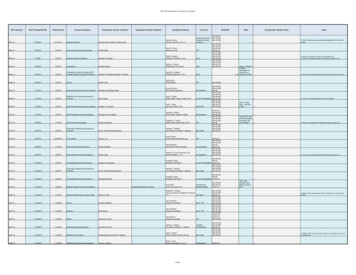
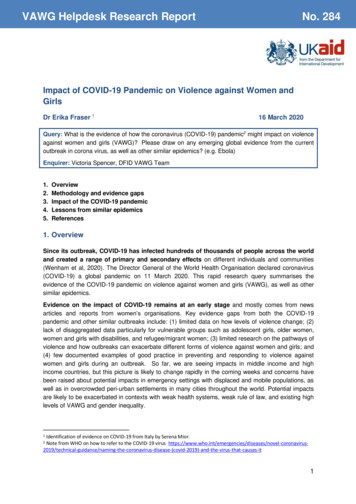

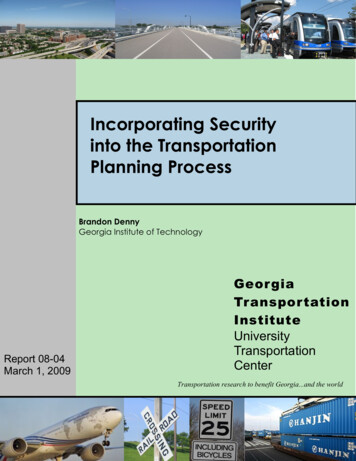
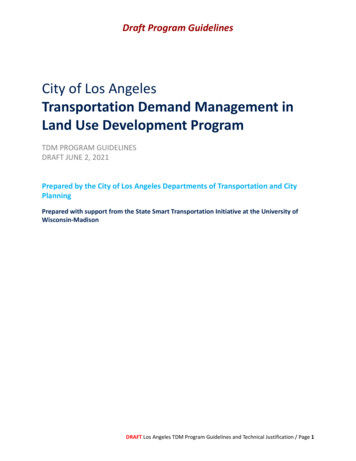
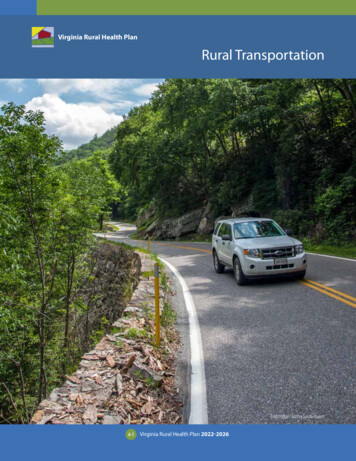
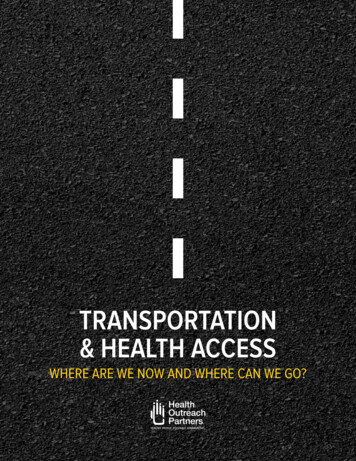
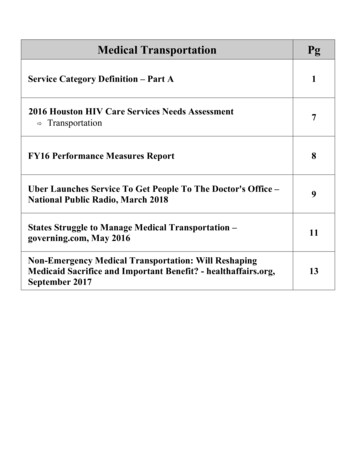
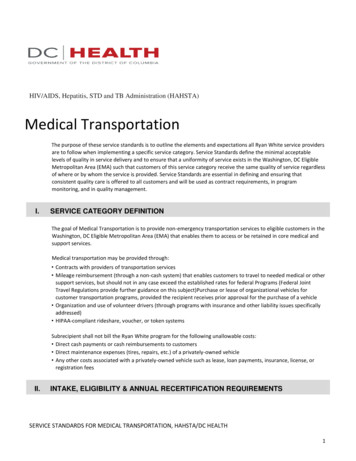
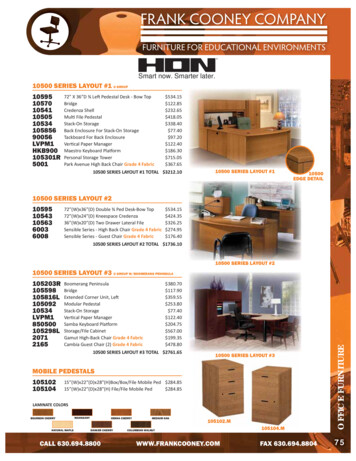
![Welcome! [benefits.cat ]](/img/7/post-64slides-oneexchange-caterpillar-combined.jpg)